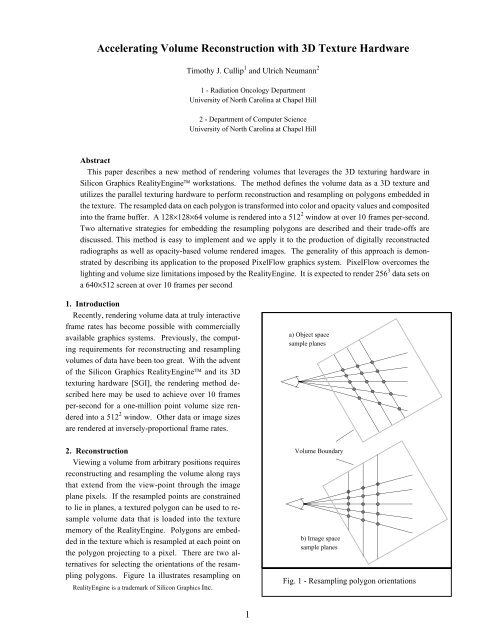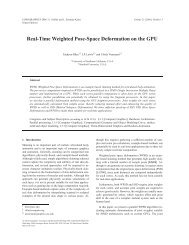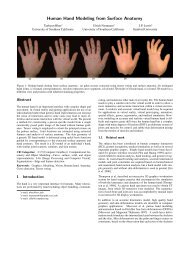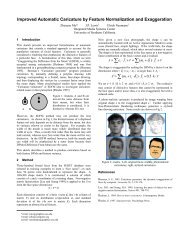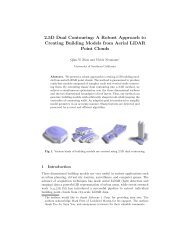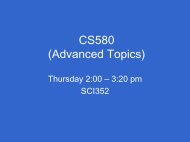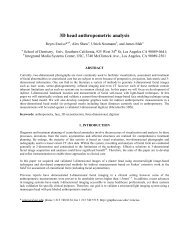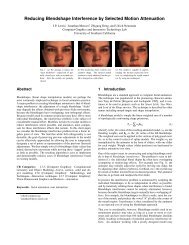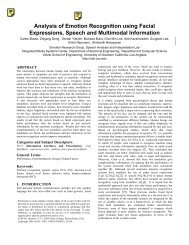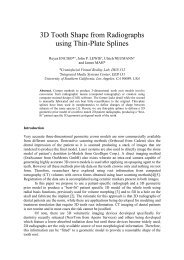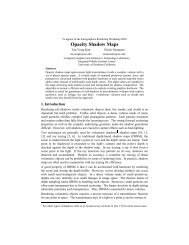Accelerating Volume Reconstruction with 3D Texture Hardware
Accelerating Volume Reconstruction with 3D Texture Hardware
Accelerating Volume Reconstruction with 3D Texture Hardware
You also want an ePaper? Increase the reach of your titles
YUMPU automatically turns print PDFs into web optimized ePapers that Google loves.
<strong>Accelerating</strong> <strong>Volume</strong> <strong>Reconstruction</strong> <strong>with</strong> <strong>3D</strong> <strong>Texture</strong> <strong>Hardware</strong><br />
1. Introduction<br />
Recently, rendering volume data at truly interactive<br />
frame rates has become possible <strong>with</strong> commercially<br />
available graphics systems. Previously, the computing<br />
requirements for reconstructing and resampling<br />
volumes of data have been too great. With the advent<br />
of the Silicon Graphics RealityEngine and its <strong>3D</strong><br />
texturing hardware [SGI], the rendering method described<br />
here may be used to achieve over 10 frames<br />
per-second for a one-million point volume size rendered<br />
into a 512 2 window. Other data or image sizes<br />
are rendered at inversely-proportional frame rates.<br />
2. <strong>Reconstruction</strong><br />
Viewing a volume from arbitrary positions requires<br />
reconstructing and resampling the volume along rays<br />
that extend from the view-point through the image<br />
plane pixels. If the resampled points are constrained<br />
to lie in planes, a textured polygon can be used to resample<br />
volume data that is loaded into the texture<br />
memory of the RealityEngine. Polygons are embedded<br />
in the texture which is resampled at each point on<br />
the polygon projecting to a pixel. There are two alternatives<br />
for selecting the orientations of the resampling<br />
polygons. Figure 1a illustrates resampling on<br />
RealityEngine is a trademark of Silicon Graphics Inc.<br />
Timothy J. Cullip 1 and Ulrich Neumann 2<br />
1 - Radiation Oncology Department<br />
University of North Carolina at Chapel Hill<br />
2 - Department of Computer Science<br />
University of North Carolina at Chapel Hill<br />
Abstract<br />
This paper describes a new method of rendering volumes that leverages the <strong>3D</strong> texturing hardware in<br />
Silicon Graphics RealityEngine workstations. The method defines the volume data as a <strong>3D</strong> texture and<br />
utilizes the parallel texturing hardware to perform reconstruction and resampling on polygons embedded in<br />
the texture. The resampled data on each polygon is transformed into color and opacity values and composited<br />
into the frame buffer. A 128×128×64 volume is rendered into a 512 2 window at over 10 frames per-second.<br />
Two alternative strategies for embedding the resampling polygons are described and their trade-offs are<br />
discussed. This method is easy to implement and we apply it to the production of digitally reconstructed<br />
radiographs as well as opacity-based volume rendered images. The generality of this approach is demonstrated<br />
by describing its application to the proposed PixelFlow graphics system. PixelFlow overcomes the<br />
lighting and volume size limitations imposed by the RealityEngine. It is expected to render 256 3 data sets on<br />
a 640×512 screen at over 10 frames per second<br />
1<br />
a) Object space<br />
sample planes<br />
<strong>Volume</strong> Boundary<br />
b) Image space<br />
sample planes<br />
Fig. 1 - Resampling polygon orientations
polygons aligned <strong>with</strong> the object-space axes. Figure<br />
1b shows resampling on polygons aligned <strong>with</strong> the<br />
image-space axes. In either case, the resampled values<br />
behind each pixel are combined to produce a color for<br />
that pixel. The combining method is often a compositing<br />
operation, but may be other operations as required<br />
by the visualization application.<br />
Polygons aligned in object-space are defined to lie<br />
<strong>with</strong>in the volume and rendered <strong>with</strong> GL library calls.<br />
This method is complicated slightly by the need to reorient<br />
the sampling polygons in the plane most parallel<br />
to the view-plane as the view-point changes. This is<br />
accomplished by examining the view matrix and explicitly<br />
creating polygons for the six cases that arise<br />
[Westover91].<br />
Polygons aligned in image-space must be clipped to<br />
the boundaries of the volume to ensure valid texture<br />
coordinates. Polygons are defined in image-space and<br />
transformed by the inverse viewing matrix into objectspace<br />
where the clipping occurs. Clipped polygons<br />
are then rendered <strong>with</strong> the usual GL library calls.<br />
In addition to using unclipped polygons, there are other<br />
advantages to using the object-space method. The<br />
texturing time for any polygon is proportional to the<br />
number of pixels it covers. A priori information about<br />
the extent of interesting features in each slice of the<br />
volume may be used to minimize the polygon size, and<br />
thus its texturing time, as a function of its location.<br />
The texture memory of the RealityEngine is limited to<br />
1M 12-bit data points. To render larger volumes, slab<br />
subsets are loaded and rendered in succession. <strong>Texture</strong><br />
memory may be reloaded in about 0.1 seconds.<br />
With the object-space method, rendering each slab is<br />
simple. The image-space method must render polygons<br />
multiple times, clipping them to the currently<br />
loaded volume slab.<br />
3. Radiographs<br />
A digitally reconstructed radiograph of medical volume<br />
data is produced by combining the resampled<br />
values behind each pixel to approximate the attenuation<br />
integral<br />
pixel intensity = 1.0 - exp(-∑ ui d ) (1)<br />
2<br />
where ui are the resample values behind a pixel and d<br />
is the spacing between sample values. Note that d is<br />
constant for all samples behind a pixel, but due to perspective,<br />
it varies from pixel to pixel. The resampled<br />
ui terms are summed at each pixel, and the d factors<br />
are applied by using an additional full-screen polygon<br />
<strong>with</strong> a 2D texture corresponding to the d values required<br />
for each pixel. The summation results may be<br />
viewed directly or the exponential required to mimic a<br />
radiograph may be computed at each pixel by using a<br />
lookup table.<br />
The RealityEngine has a maximum precision of 12bits<br />
per frame buffer and texture component. The<br />
summation could easily overflow that unless the sample<br />
values are properly scaled. Our implementation<br />
maintains 12-bit volume data values in the texture<br />
memory and scales each resampled value by a user<br />
controlled "exposure" value ranging from zero to one.<br />
The scaled samples are then summed and clamped if<br />
they exceed the 12-bit range. In practice, it has been<br />
easy to find suitable exposure control settings for the<br />
data sets tested. Figure 2 shows radiograph images of<br />
128×128×64 CT data of a human pelvis made <strong>with</strong><br />
polygons aligned in object-space.<br />
Fig. 3 - Digitally reconstructed radiographs
4. Opacity-Based Rendering<br />
The summation of samples produces radiograph<br />
images. Compositing samples produces images <strong>with</strong><br />
occlusion. Only one texture component is required for<br />
the linear attenuation coefficient used to produce<br />
radiographs. Two 8-bit texture components can represent<br />
the raw data and a precomputed shading<br />
coefficient. The resampled data component values are<br />
used as indices into an opacity lookup table. This lookup<br />
uses the texture hardware for speed. The shading<br />
coefficient is a function of the original data gradient<br />
and multiplies the sample opacity to produce images<br />
of shaded features as shown in figure 3. This figure<br />
shows the human pelvis data set above an image of a 4<br />
mm 3 volume of a chicken embryo acquired by a microscopic<br />
MRI scanner. The precomputed shading<br />
fixes the light position(s) relative to the volume. For<br />
more general lighting by sources fixed in image-space,<br />
the shade texture component must be replaced by three<br />
components containing the normalized data gradient.<br />
Unfortunately, the resampled gradient on the polygons<br />
Fig. 3 - Shaded volume rendering<br />
3<br />
is not normalized and normalization is an expensive<br />
process requiring a square root. Lighting <strong>with</strong>out normalization<br />
is possible, but this has not yet been tried to<br />
see how serious the artifacts are.<br />
5. Performance<br />
We consider two data sizes rendered into a 512 2<br />
window. The smaller data size of 128×128×64 may be<br />
rendered at ten frames per-second using 128 polygons<br />
aligned in object-space. This equates to a processing<br />
rate of 10 million voxels per-second. In our test images<br />
we measured about 160 million pixel operations<br />
per second, where each pixel operation is a trilinear<br />
interpolation of the <strong>3D</strong> texture components, a multiplication<br />
by a scaling or opacity factor, and a summation<br />
or composite into the frame buffer. The larger<br />
data size of 256×256×64 requires four 256×256×16<br />
texture slabs and is rendered at 2.5 frames per-second<br />
<strong>with</strong> 256 resampling polygons. Loading texture slabs<br />
consumes less than 0.1 seconds per-slab. A progressive<br />
refinement approach would allow a user to manipulate<br />
the low-resolution data at a high frame rate,<br />
and render the high-resolution data as soon as the user<br />
allows the motion to stop. The performance is very<br />
linear <strong>with</strong> respect to the number of pixels processed.<br />
As the number of screen pixels or resampling polygons<br />
is doubled, the frame rate is halved. If more<br />
resampling polygons are used, higher quality images<br />
are obtained at the expense of lower rendering speed.<br />
6. PixelFlow<br />
Texturing hardware is likely to be a common feature<br />
of graphics systems in the future. The PixelFlow<br />
graphics system under development at the University<br />
of North Carolina at Chapel Hill will have texturing<br />
hardware [Molnar + 92] that it is suitable for a variant of<br />
the polygon resampling approach described above for<br />
the RealityEngine. We propose a polygon texturing<br />
approach for the PixelFlow system that will overcome<br />
the limitations on realistic lighting and data size imposed<br />
by the RealityEngine. The texturing hardware<br />
in PixelFlow will allow 128 2 pixel processors to access<br />
eight arbitrarily-addressed 32-bit values in texture<br />
memory in under 500 μs. PixelFlow texturing<br />
hardware does not perform any operations on these<br />
texture values; rather, they are simply loaded into the<br />
pixel processors where a user’s program manipulates<br />
them as ordinary data. If the 32-bit values are treated<br />
as four 8-bit texture components, then three may be
used for the x, y, and z gradient components and one<br />
for the raw data. Trilinear interpolation of all four<br />
components is performed by software executing concurrently<br />
on all 128 2 pixel processors. The interpolated<br />
gradient is normalized and used to compute Phong<br />
shaded lighting coefficients. Piecewise-linear transformations<br />
are computed that translate the interpolated<br />
data value into color and opacity. The color is multiplied<br />
by the shading coefficient and composited into<br />
the frame buffer. Each of the 128 2 pixel processors<br />
has an 8-bit ALU, hardware multiply, and hardwareassisted<br />
square root and divide instructions. These assets<br />
permit the shading and classification to be performed<br />
concurrently <strong>with</strong> the next polygon texture<br />
lookups. PixelFlow systems may contain many texture<br />
engines whose results are composited over a very<br />
high speed network. Unlike the RealityEngine, each<br />
PixelFlow processor card has its own memory capable<br />
of holding 0.5 M texture values, so the size of the volume<br />
that a system can hold may be expanded by<br />
adding additional processor cards. A system <strong>with</strong> 43<br />
processor cards will handle a 256 3 volume size and<br />
render it into a 640×512 window using 400 objectspace<br />
resampling polygons at over 10 frames-per<br />
second. As in the case of the RealityEngine, performance<br />
is inversely proportional to the number of<br />
screen pixels and resampling polygons used.<br />
7. Summary<br />
We have presented a volume rendering approach<br />
that leverages the <strong>3D</strong> texturing hardware available on<br />
high-performance graphics systems. The texturing<br />
hardware accelerates the reconstruction and resampling<br />
process inherent in all volume visualization<br />
algorithms. A working implementation of this approach<br />
for the Silicon Graphics RealityEngine is<br />
described, and radiographs and opacity-based volume<br />
visualizations are demonstrated. This approach is easily<br />
implemented and produces the highest performance<br />
rendering rates ever reported for a commercially available<br />
system. The application of this approach to the<br />
proposed PixelFlow graphics system is also presented.<br />
PixelFlow will provide scalable volume rendering<br />
performance and data capacity beyond that of any systems<br />
currently available.<br />
4<br />
8. References<br />
[Molnar + 92] Steven Molnar, John Eyles, and John<br />
Poulton. "PixelFlow: High-Speed Rendering<br />
Using Image Composition." Computer Graphics<br />
26(2):231-240, July 1992. Proceedings of<br />
SIGGRAPH’92.<br />
[SGI] Greg Estes and Joshua Mogal. "Its’<br />
Time to Get Real." Iris Universe (21):15-19,<br />
Summer 1992. Silicon Graphics Inc.<br />
[Westover91] Lee Westover. "Splatting - A Parallel,<br />
Feed-Forward <strong>Volume</strong> Rendering Algorithm."<br />
Dept. of Computer Science, UNC at Chapel<br />
Hill, Tech Report TR91-029, July 1991. Ph.D.<br />
Dissertation.


